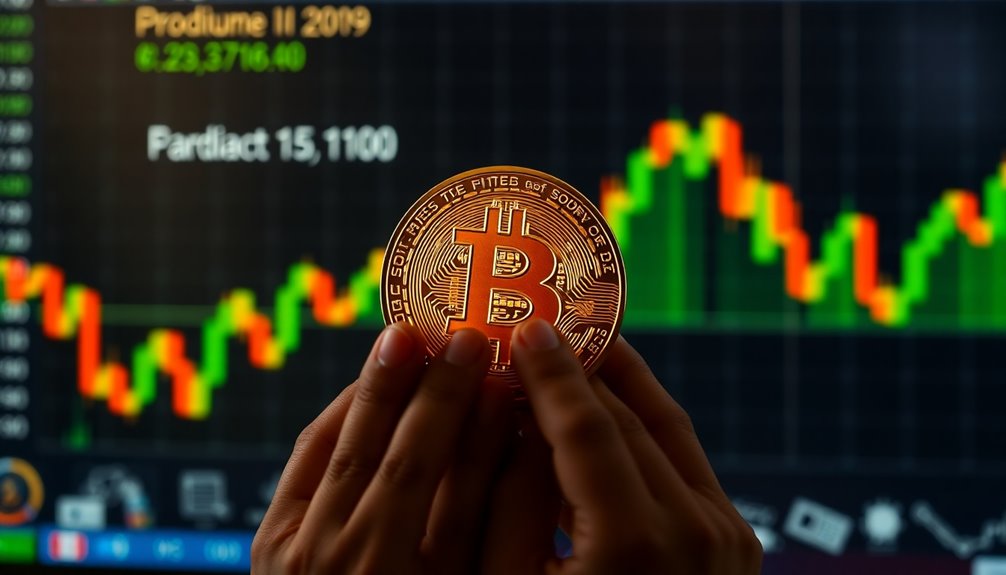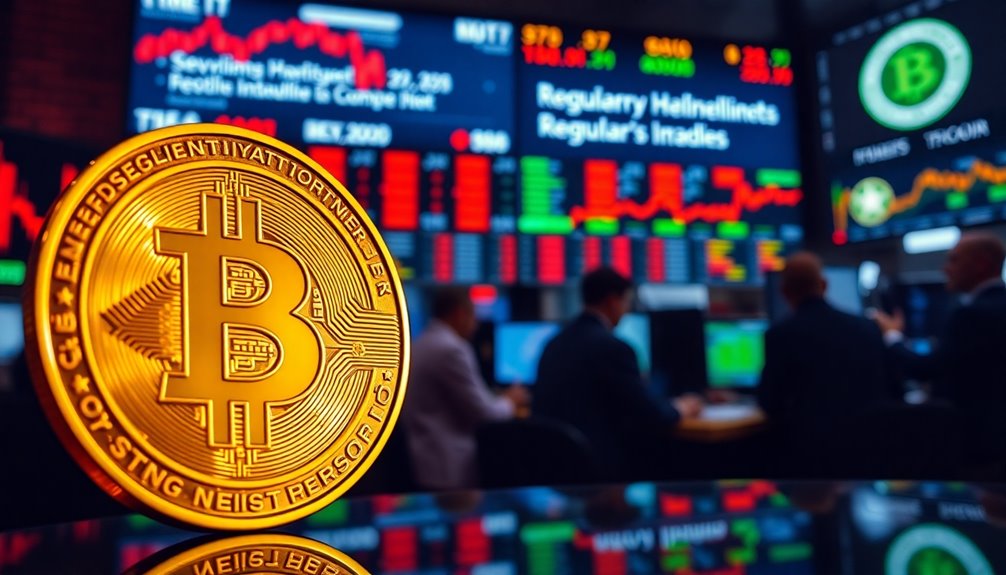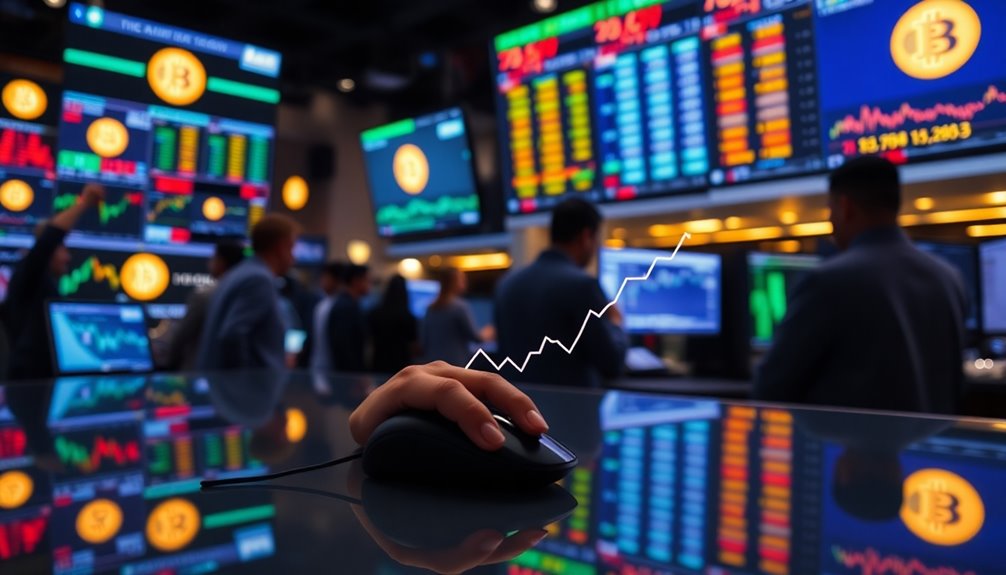Bitcoin's market shows impressive resilience and profitability, even amid recent price declines. With over 90% of holders enjoying gains, institutional investments from giants like Goldman Sachs and BlackRock boost market sentiment and stability. The limited supply and strong demand further support prices. Regulatory changes also enhance confidence among investors. This unique combination of factors fosters a bullish outlook for Bitcoin. There's much more to uncover about its future potential and evolving dynamics.
Resilience Amid Market Volatility

While many investors feel anxious during market downturns, Bitcoin's resilience shines through, thanks to a robust support structure that stabilizes prices. You'll notice that despite recent price declines, Bitcoin maintains a solid foundation, with key support levels helping to cushion falls. Institutional adoption has further strengthened this market, encouraging stability and reducing speculative intensity. Economic uncertainty also enhances Bitcoin's role as a safe-haven asset, drawing in investors seeking security. Plus, the Market Value to Realized Value (MVRV) ratio indicates that Bitcoin trades above its one-year mean, showcasing positive sentiment. As long-term holders return to accumulation, Bitcoin's market continues to mature, demonstrating its capacity to withstand volatility and emerge stronger. Furthermore, implementing risk management strategies can help investors navigate through fluctuations more effectively, ensuring a well-rounded approach to their portfolios. Moreover, with institutional inflows into Bitcoin ETPs projected to exceed $250 billion, the demand for Bitcoin remains robust, further solidifying its position in the market.
Profitability of Bitcoin Holders

The profitability of Bitcoin holders remains impressive, with over 90% enjoying gains despite recent market fluctuations.
Long-term holders are reaping substantial rewards, with projections suggesting gains could exceed 500% if Bitcoin reaches $150,000. Bitcoin's historical cycles indicate that these gains may align with past performance trends, further encouraging long-term investment. Short-term holders aren't left behind either, averaging a moderate profit of about 14.5%. Digital asset management is crucial for maximizing these profits through strategic organization and security.
Even new investors, those holding Bitcoin for less than a month, are seeing small gains around 4.7%. This overall profitability fosters a bullish market sentiment, making widespread sell-offs less likely.
Factors like miner profitability and historical trends support this resilience, as long-term holders continue to accumulate Bitcoin, reducing supply.
With ongoing inflationary pressures, many view Bitcoin as a hedge, further solidifying its value in the market.
The Role of Institutional Investment

With a strong foundation of profitability among Bitcoin holders, the market now sees a significant shift driven by institutional investment.
Approximately 20% of US-traded spot Bitcoin ETFs are held by around 1,179 institutions, amounting to over 193,000 BTC. Major players like Goldman Sachs and BlackRock, through its iShares Bitcoin Trust ETF, are significantly influencing the landscape. This institutional investment not only boosts market sentiment but also correlates strongly with price movements, often leading to substantial surges. As these institutions continue to buy, they reduce Bitcoin's volatility and enhance its attractiveness as a store of value.
Experts predict that this growing demand could push Bitcoin's price beyond $100,000 by early 2025, signaling a promising future for the asset.
Regulatory Developments and Their Impact

As the crypto market evolves, regulatory developments are playing a crucial role in shaping its future. You'll notice significant shifts aimed at creating clearer frameworks for digital assets. The expected passage of stablecoin legislation in the U.S. could boost institutional confidence, while the EU's MiCA regulations tighten oversight, excluding non-compliant players. Compliance is now mandatory, marking a departure from the sector's historically under-regulated nature. These changes drive market maturation, though stricter rules might challenge altcoins. Meanwhile, the U.S. is focusing on maintaining dollar sovereignty without introducing Central Bank Digital Currencies. Additionally, the market's resilience is reflected in the current investor stress levels, which remain low despite recent corrections. This regulatory clarity is essential as it helps to mitigate the risks associated with high volatility risks in cryptocurrency markets.
Historical Price Patterns and Future Projections

Regulatory clarity has paved the way for a deeper understanding of Bitcoin's historical price patterns and their implications for future projections.
You've seen Bitcoin's journey from under $0.10 in 2010 to peaks over $19,000 in 2017 and $42,258 in 2023. Each cycle reflects volatility, with significant drops like the 2014 decline and the 2022 dip below $20,000. Additionally, Bitcoin's first halving event in November 2012 marked a pivotal moment that influenced subsequent price movements.
Yet, patterns indicate resilience, as seen in the 2019 recovery and the COVID-19 surge. On-chain metrics like the Puell Multiple and MVRV Z-Score suggest potential upside, while active address sentiment hints at growing retail interest.
As you look ahead, the bullish momentum starting in 2025 could lead to new highs, but market conditions will ultimately shape the future.
Economic Factors Affecting Bitcoin

The interplay of economic factors significantly shapes Bitcoin's demand and price movements. The limited supply of 21 million coins means that as demand increases, prices often rise.
During uncertain global economic conditions, many investors turn to Bitcoin as a hedge against inflation, boosting its appeal. Conversely, higher interest rates can dampen speculative investments, negatively impacting prices. Additionally, favorable regulations can enhance mainstream acceptance, driving demand upward. Economic expansions typically lead to greater wealth allocation towards alternative assets like Bitcoin, while recessions can reduce this demand. Notably, positive regulatory developments can create a favorable trading environment that supports Bitcoin's price stability. Moreover, decentralized finance is becoming a significant factor in how investors perceive Bitcoin's role as an alternative asset. Lastly, global economic uncertainty and fiat currency volatility can trigger fluctuations in Bitcoin's price, underscoring the intricate connection between macroeconomic events and the cryptocurrency market.
Technological Innovations in the Bitcoin Ecosystem

Economic factors undeniably influence Bitcoin's market dynamics, but technological innovations are equally pivotal in shaping its future.
The blockchain technology at Bitcoin's core ensures secure, decentralized transaction recording. With the Proof-of-Work consensus, you can trust the network's integrity. Additionally, recent developments show that new Bitcoin holders are absorbing a significant portion of the supply, reflecting strong demand.
Exciting developments like the Lightning Network enable faster, cheaper transactions, addressing Bitcoin's scalability challenges and making micropayments feasible. Smart contract functionality is emerging, expanding Bitcoin's utility into DeFi, while sidechains enhance interoperability with other platforms.
Upgrades like Taproot and Schnorr signatures improve privacy and security, ensuring your transactions remain confidential. As Bitcoin continues to evolve with these innovations, it solidifies its position as a resilient and adaptable player in the cryptocurrency landscape, ready to meet your needs in an ever-changing market.
Market Sentiment and Investor Behavior

While market sentiment can fluctuate rapidly, it plays a crucial role in shaping investor behavior around Bitcoin. Currently, the MVRV ratio indicates that the average holder enjoys a 32% unrealized profit, which helps maintain a positive outlook. Despite recent price corrections, investor stress levels remain moderate, suggesting resilience in the market. Many see these dips as opportunities, often leading to increased interest in Bitcoin. Notably, significant buying interest has been identified between $85,000 and $92,000, which could act as a potential support level. Short-term holders may be feeling the pinch, but institutional participation is growing, lending stability to the market. Additionally, regulatory clarity is on the horizon, which could further boost confidence. As you navigate this landscape, keep an eye on these dynamics to inform your investment strategies.
The Future of Bitcoin in a Changing Landscape

As Bitcoin navigates a rapidly evolving landscape, its future hinges on several critical factors that could shape its trajectory.
Strong on-chain metrics indicate high demand, with more idle Bitcoin being absorbed than new supply from miners. Regulatory clarity and institutional adoption, especially through ETFs, are set to bolster Bitcoin's growth. Recent data shows that 90% of Bitcoin supply is currently in profit, further emphasizing the market's robust fundamentals.
You'll also notice that technological advancements enhance its stability and resilience, making it more appealing across various sectors.
However, macroeconomic conditions, like Federal Reserve policies and dollar strength, will influence Bitcoin's allure as an investment.
Keeping an eye on these elements will be crucial for understanding how Bitcoin can thrive amid challenges and continue its ascent in a complex financial ecosystem.
Conclusion
In spite of recent price declines, the Bitcoin market proves its resilience and profitability. You can see how institutional investment and ongoing regulatory developments are shaping its future. As you navigate this landscape, stay aware of historical price patterns and the economic factors at play. Embrace the technological innovations and pay attention to market sentiment. By doing so, you'll be better positioned to make informed decisions about your Bitcoin investments going forward.









